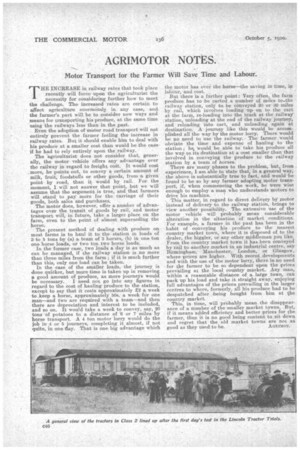AGRIMOTOR NOTES.
Page 46

If you've noticed an error in this article please click here to report it so we can fix it.
Motor Transport for the Farmer Will Save Time and Labour.
THE INCREASE in railway rates that took place recently will force, upon the agriculturist the necessity for considering further how to meet the challenge. The increased rates are certain to Week agriculture enormOusly in any case, and the farmer's part will be to consider new ways and means for transporting his produce, at the same time using the railways less than in the past.
Even the adoption of motor road transport will not entirely prevent the farmer feeling the increase in railway rates. But it should enable him to deal with his produce at a smaller cost than would be the case if he had to rely entirely upon the railway.
The –agriculturist does not consider that, generally, the motor vehicle offers any advantage over the railway in regard to freight coat. It would cost more, he points out, to convey a certain amount of milk, fruit, foodstuffs or other goods, from a given point by road, than it would by rail. For the moment, I will not answer that point, but we will assume that the argument is true, and, that farmers will stand to pay more for the carriage of their goods, both sales and purchases.
The motor does, however, offer a number of advantages over the transit of goods by rail, and motor transport will, in future, take a larger place on the farm, even to the point of almost superseding the horse.
The present method of dealing with produce on most farms is to haul it to the station in loads of 3 to 5 tons by (a) a team of 3 horses, (b) in one ton one horse loads, or two ton two horse loads.
In the former case, two loads a day is as much as can be managed, if the railway station is no more than three miles from the farm ; if it is much further than this, only one load can he taken.
In the case of the smaller loads, the journey is done quicker, but more time is taken up in removing a good amount of produce, as More journeys would be necessary. I need, not go into any figures in regard to the cost of hauling produce-to the station, except to say that it costs approximately £2 a week to ,keep a horse, approximately 50s. a week for one man—and two are required with a team—and then there are depreciation and interest to be included, and so on. It would take a week to convey, say, 20 tons of potatoes to a distance of 6 or 7 miles by horse transport. A 4 ton motor lorry would do the job in 4 or 5 journeys, completing it almost, if not quite, in one day. That is one big advantage which
the motor has over the horse—the saving in time, in lab'o'ur, and cost.
But there is a further point : Very often, the farm produce has to be carted a number of miles to.the railway station, only to be conveyed 20 or 30 miles by rail, which involves loading up on to the cart at the farm, re-loading into the truck at the railway station unloading at the end of the railway journey, and reloading into, cart, and unloading again at destination. .A journey like this would be accomplished all the way by the motor lorry. There would be no need to use the railway.The' farmer would obviate the time and expense of hauling to the station ; he would be able to take his produce all the wayto. its destination at a cost smaller than that involved in conveying the produce to the railway station by a team of horses.
There are many phases to the problem, but, from experience, I am able to state that, in a general way, the above is substantially true to fact, and would be found to be so by any farmer adopting motor transport, if, when commencing the work, he were wise enough to employ a man who understands motors to drive his machine. •
This matter, in regard to direct delivery by motor instead of delivery to the railway Station, brings to view another possibility. The extensive use of the motor vehicle will probably mean considerable alteration in the situation of market conditions. For example, a farmer in the past has been in the habit of conveying his produce to the nearest country market town, where it is disposed of to the dealer, the higgler, or any other middleman you like. From the country market town it has been conveyed by rail to another market in an industrial centre, say Birmingham,Manchester, London, or Glasgow, where prices are higher. With recent developments and with the use of the motor lorry, there is no need for the farmer to be so 'dependent upon the prices prevailing at the local country market.. Any man, within a reasonable distance of a large town, can pack up his load and take it straight away, enjoying full advantages of the prices prevailing in the larger centres to where, formerly, all his produce had to be despatched after being bought from him at the country market.
This, in time, will probably mean the disappearance of a number of the smaller market towns. But, if it means added efficiency and better prices for the farmer, then it is no good being content to .sit down and regret that the old market towns are not as
good as they used to be. A GR IMOT.




















































